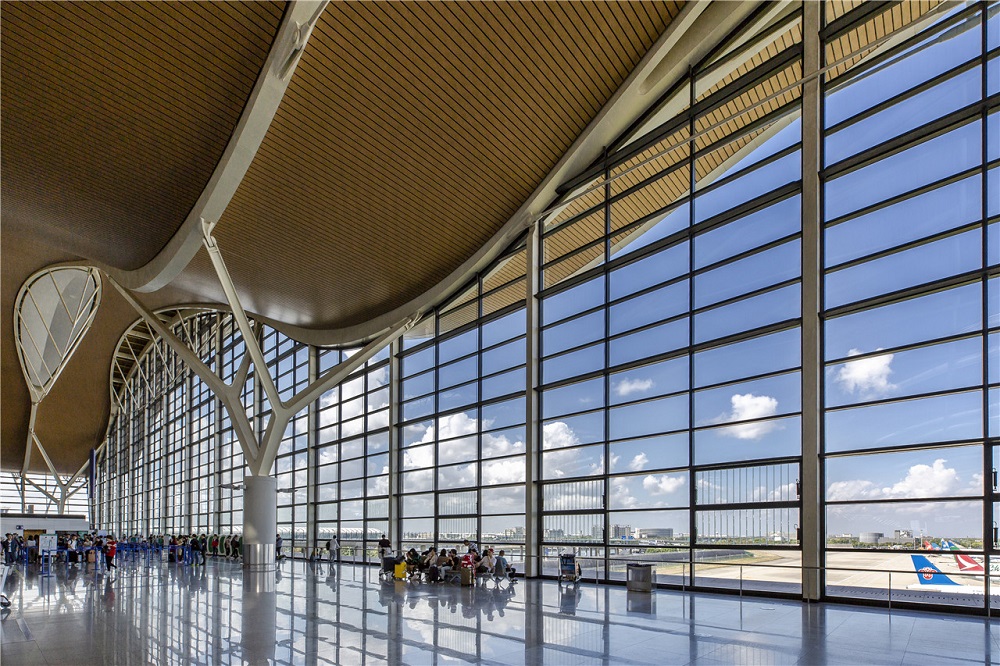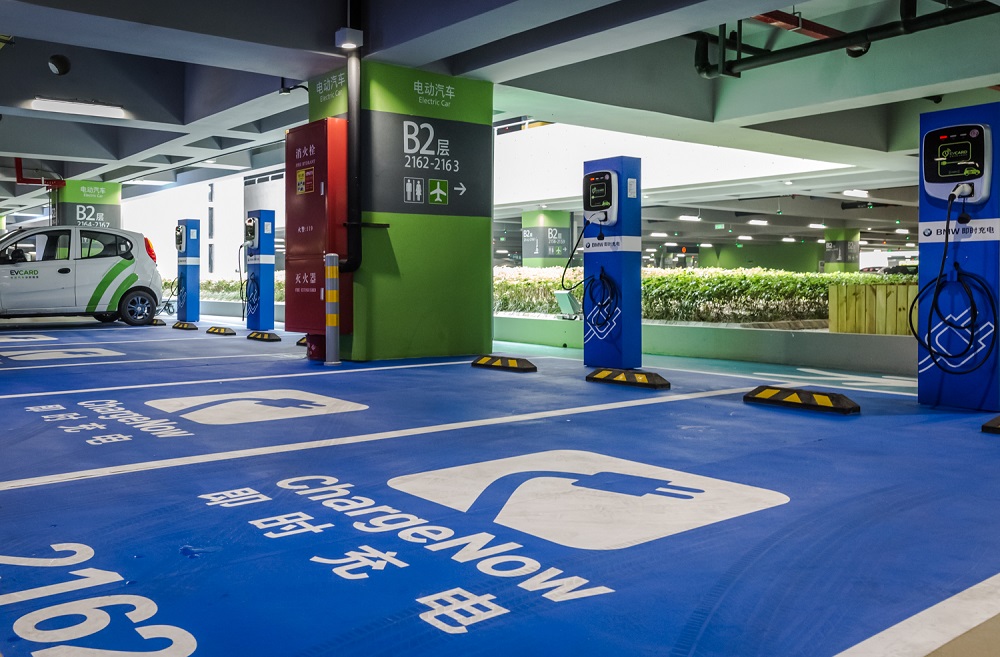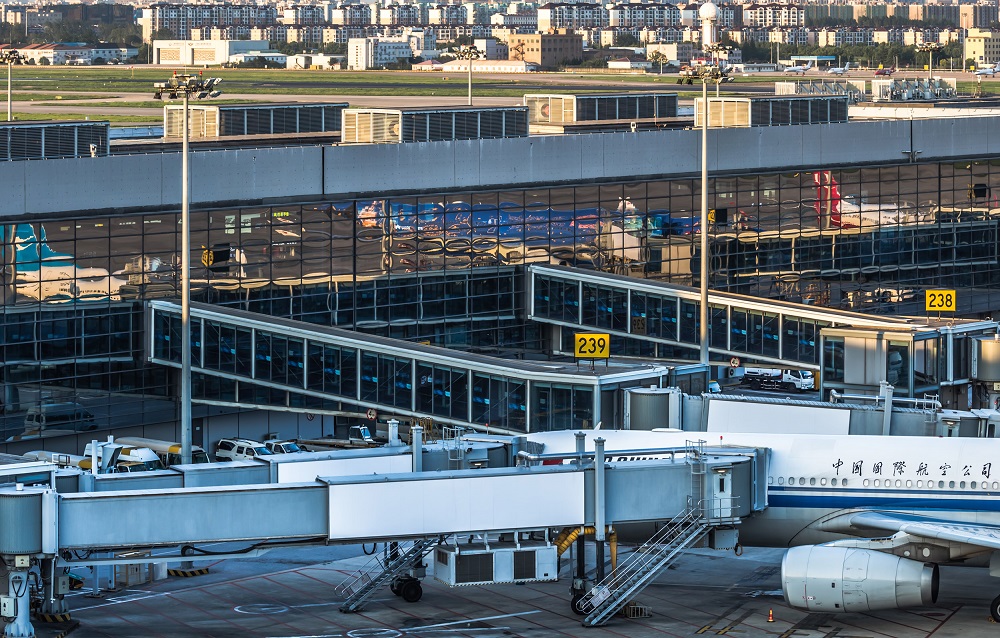Shanghai Airport Authority has made great efforts to save energy and develop in a green way in line with the national strategy of ecological civilization construction and the requirements proposed by the Civil Aviation Administration of China.
At the beginning of 2019, the authority, which is in charge of Shanghai Pudong International Airport and Shanghai Hongqiao International Airport, released a three-year implementation plan to “change from oil to electricity” and develop six environmental protection projects, two construction plans and 23 supporting management measures to speed up the construction of green airports aimed at making the skies blue again.
Green elements contained in airports’ designs
The design of Pudong and Hongqiao airports stuck to the sustainable development concept featuring green and low-carbon strategies which had been carried out during the two airports’ construction and early operations.
In its planning in 2004, Pudong airport changed the 760-meter runway to 440 to 460 meters, which saved a great amount of land. In the 2005 plan for Hongqiao airport, two runways, which were originally designed to be 1,700 meters apart, were changed to be 365 meters apart. In their designs, the two airports saved about 16 square kilometers of land for Shanghai.

The authority was the first civil aviation body in China to propose turning off the ground power when planes park so the terminals can open skylights instead of using air conditioning. This helps to achieve the goal of low-carbon and energy conservation. The Satellite Hall at Pudong airport, which will be put into use very soon, was designed in line with the standards of green buildings. It will preserve the advantages of the old terminal in terms of natural lighting and ventilation and maximize the efficiency of air conditioners by blocking off the space between the upper and lower layers.
Hongqiao airport carried out renovations to its terminal T1 in 2017 which achieved the goals of comfort and energy conservation, while improving the efficiency of the terminal by 25 percent. Following the concept of green and sustainable development, the renovation transformation plan won the 2017 green solution prize given by United Nations Climate Change Conference (COP 23).
Terminal T2 at Pudong airport has followed the concept of energy-saving so well it can save 130 million kilowatt hours and 15.75 million yuan ($2.3 million) on annual operating expenses. The second-phase energy-saving project at the airport won the gold prize at the 2008 Shanghai International Energy Conservation and Emission Reduction Expo. The energy center at Hongqiao airport employs an advanced air-conditioning system which can reduce energy consumption by 20 percent.
New technologies save energy
Pudong and Hongqiao airports have spent a lot of money to introduce new technologies and equipment transformation to achieve energy conservation.

In the past five years, the two airports have carried out a series of projects to transform electronic equipment, including lighting facilities, elevators and lifts, and water pumps, and have achieved greater efficiency in energy conservation. In four years, Pudong airport has replaced its original lighting facilities with more than 100,00 LED energy-saving lamps, saving about 39 million kWh a year.
The two airports have adopted different operation strategies at functional areas, such as check-in, security-check, waiting and dining areas, based on changes in seasons. Management strategies are also used to control air conditioning and lighting systems, helping to save more energy.
Every terminal at the two airports has been equipped with an energy center which has adopted advanced energy supply systems to help improve efficiencies in the utilization of energy and solve the contradictions between power demands and supply.
New energy sources have also been introduced at the two airports. In 2014, the first megawatt photovoltaic power station for civil aviation started to operate at Hongqiao airport’s west cargo area. With an installed capacity of 3.4 mW, the station can supply 10 percent of the airport’s daytime energy requirements. In the same year, the P1 and P2 parking stations at Pudong airport also put into use a new power generation project. With an installed capacity of 1.7 mW, the project mainly provides power for lighting and electromechanical devices in the garage areas. Solar water heating systems are also employed at Hongqiao airport at its western energy center and in the roof of Terminal 2.
‘Changing from oil to electricity’
New energy vehicles (NEV) have been widely used at the two airports. Early in 2015, both airports introduced 15 NEVs. In 2016, Pudong airport introduced 12 gas-electric hybrid cars to guide planes and employed 123 pure-electric freight forklifts. In 2017, Pudong airport made 30 NEVs available for leasing and set up 10 sites for car leasing and returning, 43 charging piles and 71 parking spots. The two airports also made plans to set up charging piles at parking lots. So far, Pudong and Hongqiao airports have set up 173 and 214 charging piles respectively.

According to the requirements of the Civil Aviation Administration of China, the two airports have signed contracts with airlines on ground auxiliary power supply services, aiming to reduce carbon dioxide and oxycarbide emissions from planes. The airports plan to further improve their capacity in green services.




